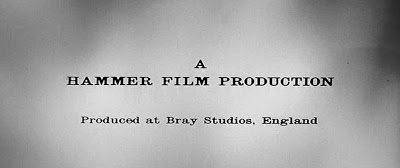Hidden Hammer Delights
By
Kristin Battestella
After
being unable to find several of these elusive films from Hammer Studios in
stores, streaming, or on the almighty Netflix, I was surprised to receive this Hammer Horror Series Franchise Collection set
for Christmas. Though they may be lesser known Hammer fare, this quartet is worth
the pursuit indeed for the horror laymen or the Hammer enthusiast.
Kiss
of the Vampire – This 1963
side-quel in the studio’s Dracula franchise
has all the expected color, gothic design, and vivid style of its compatriots.
There are some interesting filming touches, camera angles, and good old Bray
Studios again, too. This uncut original
88 minutes has all its intended blood and juicy intact as well, and the
foreboding music and turn of the century costumes complete the spooky
atmosphere. Good screams, sexy chicks lying in wait for some fangs – it’s all
almost enough to combat the run of the mill, good for background, looks like a
Hammer Film casting. We feel for Edward de Souza (also of Hammer’s The Phantom of the Opera) as the
proverbial blood hits the fan, but the ensemble is just too British bland. It’s
tough to make a Hammer vampire picture without any stars. Though creepy, the premise is typical as well –a honeymooning
couple’s car breaks down before a dreary hotel and then a bizarre invitation to
dine with the local noble of sinister repute arrives. There are pictures of
folks who haven’t aged and a masquerade ball/cult scene, too. One would swear
this was a recent movie! I know it sounds all flash and no substance, but the
subtle religious hints and possibilities of vampirism as a disease or social
club are intriguing. To modern eyes, the finale special effects might seem
corny, but the conclusion is a fitting, intense, top shelf twist on this
entertaining little piece.
Nightmare – Oft Hammer compatriots Freddie Francis and Jimmy
Sangster team up for this very moody and effective 1964 black and white
thriller. Eerie music and smart uses of silence and diegetic sound accent the sixties
styles, snow scenery, and mysterious country estates. Excellent light and
shadow, candlelight and silhouettes also push the insanity fears, paranoia,
violence, murder, and creepy ladies over the edge. There’s a wonderful,
scream-filled flashback adding to the mystery, and solid suspense filming works
for both the nightmare bizarre and the askew real world, too. Is crazy
inherited? What does childhood trauma do to the mind? Or is there something
else at work entirely? Some of the
screams might be a bit too much, and at first, one may think this is merely an
extended Twilight Zone episode.
However, some added kink keeps the audience wondering how far the terrors are
going to go. The twists keep on coming for not one long Twilight Zone, but rather this invokes a lot of TZ-esque tricks woven together – and it
works.
Paranoiac – Everybody’s swindling somebody and pulling over
the wool in this 1963 suspense filled twister, another from director Freddie
Francis and writer Jimmy Sangster. To start, the situations or red herrings may
seem obvious or the premise standard – insanity, mistaken identity,
inheritance, incest and all that given and taken from Josephine Tey’s source
novel. However, the cast keeps it interesting, and wow Oliver Reed is so young!
He makes for a great drunken playboy, of course, and Janette Scott (School for Scoundrels) is also honest
and charming in what can so easily turn into annoying hysteria. The country
house, classic cars, Old World décor, and
sixties glam also work wonderfully with solid camera work and the black and
white crisp photography. Contrast and shadow lighting also add to the
foreboding, religious symbolism, and kinky crazy implications between Reed (Curse of the Werewolf), nasty French
nurse Liliane Brousse (Maniac), and
harsh aunt Sheila Burrell (The Six Wives
of Henry VIII) – not to mention the suicide plotlines. It’s all a bit racy
for the time, and although I don’t really see any Psycho connections, these people have every right to the eponymous
paranoia. The creepy music hastens the puzzle, and the solid pace makes this
one feel longer and deeper than 80 minutes. I’m surprised more Hammer fans
don’t talk about this piece. Sure, it’s not uber horror and some scenes might
be hokey now. However, the eerie atmosphere and dang good fright moments keeps
this one entertaining.
And
a Split
Decision
The
Phantom of the Opera – This 1962
Hammer adaptation of the oft-recounted Gaston Leroux tale moves the music to
the creepy bowels of London
and doesn’t star any of the studio’s more famous leads. Director Terence Fisher
also strays from his usual flair with erroneous, herky-jerky camera zooms. A
production like this should be a polished, colorful presentation, even a
spectacle, not some misunderstood Phantom’s viewpoint cinema. Surprisingly, Michael Gough is also on the
nose as the slick and snotty Lord Ambrose, the rest of the cast is un-dynamic,
the decrepit Phantom make-up is uninspired, and the obviously dubbed operas are
a downer, too. This rendition isn’t so much a carnival musical as it is a
macabre looking period piece with some stage numbers in it, and for 84 minutes,
the pacing is slow and stagnant. Though the good scares and fright moments are
too few and far between, there is some visual value in the quality turn of the
century décor, top hats, gas lamps, velvets and lace. Hammer completists or Phantom obsessed can enjoy this unique take – it’s flawed, but also
must be seen for its dark interpretation.
The Hammer Horror Series Franchise Collection also included four more well-known Hammer Films. Feel
free to continue with our previous reviews of the following:







No comments:
Post a Comment